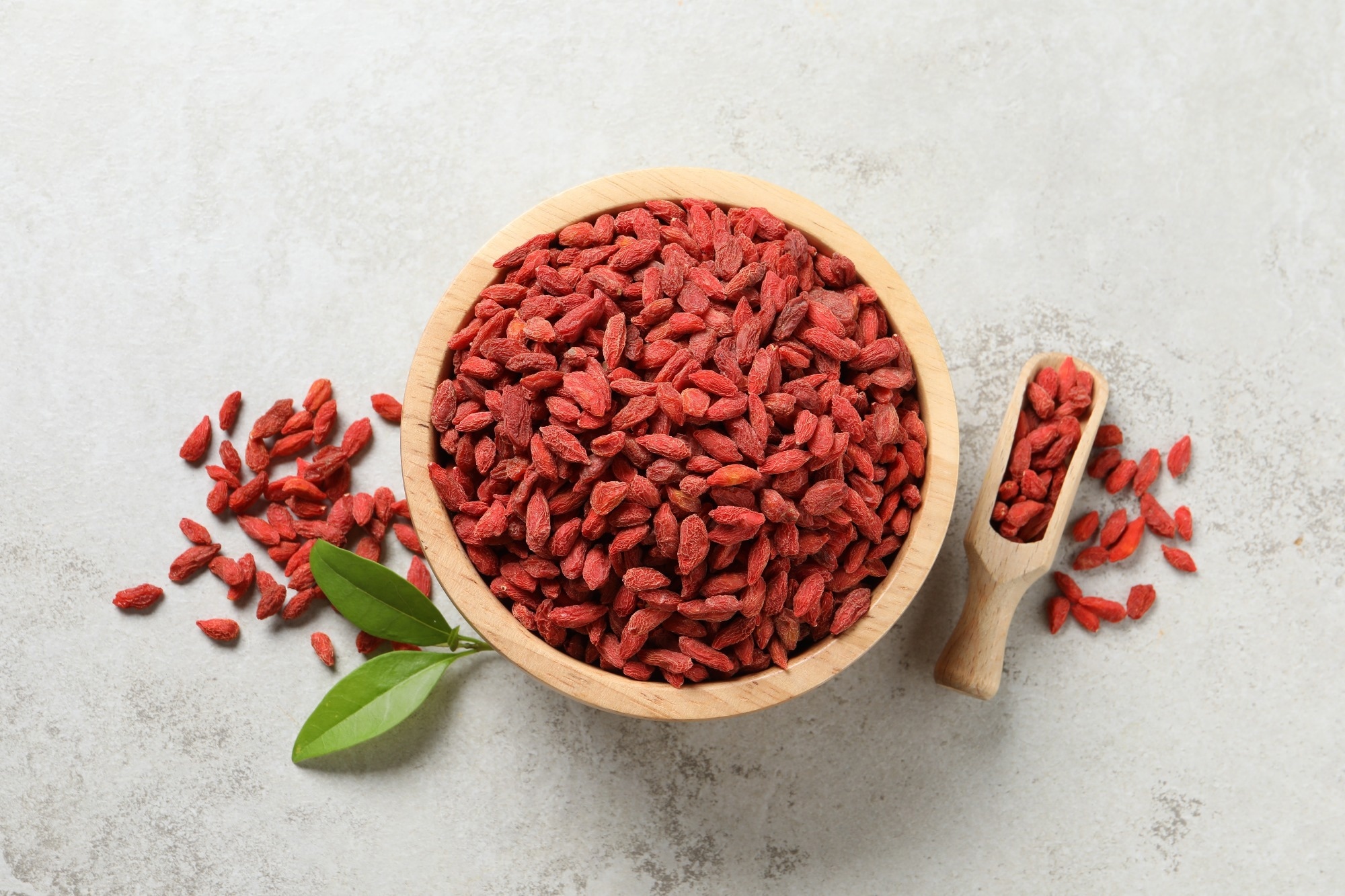Introduction
Nutritional and phytochemical profile
Immune-modulating properties
Antioxidant and anti-aging effects
Metabolic, cardiovascular, and neurological health
Safety, dosage, and potential interactions
Conclusions and research outlook
References
Further reading
Goji berries, long valued in traditional Chinese medicine, are now supported by modern studies showing benefits for metabolism, immunity, and eye health. Their bioactive compounds, especially polysaccharides and zeaxanthin, contribute to antioxidant, anti-aging, and neuroprotective effects.
 Dried Goji berries.Image Credit: New Africa / Shutterstock.com
Dried Goji berries.Image Credit: New Africa / Shutterstock.com
Introduction
The goji berry is a fruit of the Lycium barbarum plant that has been historically used in traditional Chinese medicine (TCM) as a potent medical intervention for over 2,000 years.1
Traditionally called 'gouqizi', goji berries have been used as a tonic to support the liver and kidneys, brighten the eyes, and confer longevity. Other traditional applications included treating conditions associated with metabolic and age-related decline, such as blurry vision, fatigue, and diabetes.2
More recently, goji berries are widely considered ‘superfruits’ due to their dense nutritional profile and high antioxidant capacity. These potential health benefits have led researchers to isolate specific bioactive compounds and investigate their effects on quantifiable cellular pathways and clinical biomarkers. In traditional use, typical daily intake is 6–18 g of dried fruit, rising to 15–30 g when used as a main herb; ~15 g provides about 3 mg of zeaxanthin relevant to macular health.1,2,3
Nutritional and phytochemical profile
A 100-gram (g) serving of dried goji berries contains approximately 5.3–14.3% protein, 3.6–16 g of dietary fiber, and a rich profile of vitamins and minerals, including vitamin A as carotenoid precursors, vitamin C, riboflavin, iron, potassium, and selenium.4
The therapeutic potential of goji berries is attributed to their bioactive phytochemicals, including the widely studied Lycium barbarum polysaccharides (LBPs). LBPs are complex and water-soluble glycoconjugates that constitute 5-8% of the dried fruit's weight and play a key role in the immune-modulating and metabolic benefits of goji berries.2
Goji berries are also among the richest natural sources of zeaxanthin, a critical carotenoid for vision health. Their antioxidant activity further stems from diverse phenolic compounds, including flavonoids (e.g., quercetin, rutin) and phenolic acids such as chlorogenic acid.5
Immune-modulating properties
LBPs possess a capacity for bidirectional immune regulation, as they can amplify a suppressed immune response while simultaneously downregulating a hyperimmune reaction.6
Since LBPs are largely indigestible, they function as prebiotics in the colon where they are fermented by beneficial bacteria. This process yields short-chain fatty acids (SCFAs), which strengthen the intestinal barrier, prevent systemic inflammation, and modulate immune responses.7
Animal models of ulcerative colitis have shown that LBPs improve tight junction protein expression, increase probiotic abundance, and reduce inflammatory cytokines, confirming their strong prebiotic effect.7
Antioxidant and anti-aging effects
Goji berries scavenge free radicals while upregulating endogenous antioxidant defense systems, including enzymes like superoxide dismutase (SOD) and catalase (CAT).This antioxidant activity can protect the skin, nerves, retina, and other organs that are at a greater risk of age-related damage.1
Zeaxanthin is known to accumulate in the macula, where it simultaneously acts as a filter for damaging blue light and a potent localized antioxidant. The high concentration of this critical carotenoid provides a scientific basis for the traditional use of goji berries for supporting eye health.1,2
Metabolic, cardiovascular, and neurological health
A 2021 systematic review and meta-analysis of randomized controlled trials (RCTs) concluded that daily goji berry consumption significantly improves key lipid and glucose markers. Specifically, goji berry supplementation reduced serum triglyceride and low-density lipoprotein (LDL) cholesterol levels while substantially increasing high-density lipoprotein (HDL) cholesterol. Goji berry supplementation also had a moderate to large effect on reducing fasting blood glucose levels.9
The mechanisms underlying these effects are multifaceted and likely include improved insulin sensitivity and pancreatic β-cell function. Although preclinical research suggests broader cardioprotective effects, such as normalizing blood pressure in animal models, human clinical trials, though limited, have not reported a significant impact of goji consumption on blood pressure.3
A meta-analysis pooling data from four RCTs using a standardized goji berry juice observed significant improvements in feelings of calmness, mental acuity, focus, and sleep quality, along with reduced feelings of stress and fatigue. Preclinical studies and general reviews support the potential neuroprotective effects associated with goji berries; however, specific clinical data on mood disorders remain limited.2
The prebiotic effects of LBPs on the gut microbiome may also have positive downstream effects on immunity, systemic inflammation, and neurological function.7
 Goji berries. Image Credit: Izf / Shutterstock.com
Goji berries. Image Credit: Izf / Shutterstock.com
Safety, dosage, and potential interactions
Although goji berries provide several physiological benefits, their safe consumption requires understanding dosages, contraindications, and drug interactions. The most significant drug interaction is between goji berries and the anticoagulant warfarin, with multiple case reports describing elevated INR and bleeding following goji intake.3
Caution is also advised when combining goji berries with antidiabetic or antihypertensive drugs, as their effects may be potentiated, thereby increasing the risk of hypoglycemia or hypotension. Consumption during pregnancy is considered particularly unsafe due to the presence of betaine, which may induce uterine contractions.3
In the United States, goji berries are regulated as a food or dietary supplement, a framework that does not require pre-market approval for safety and efficacy from the U.S. Food and Drug Administration (FDA).This has led to documented quality control issues, with research highlighting problems in the development and deep processing of goji berry products. Thus, it is essential for consumers to purchase goji berries from reputable suppliers and consult with a medical health practitioner before self-dosing. 2,11
Conclusions and research outlook
L. barbarum is a nutritionally dense fruit with a unique phytochemical profile that provides a wide range of health and mood benefits. Robust evidence from human trials supports its efficacy in improving metabolic health, enhancing immune function, protecting vision, and enhancing subjective well-being.
Despite these findings, many purported benefits are primarily supported by preclinical data or animal model-based investigations, thus emphasizing the importance of conducting more large-scale and long-term human trials in the future. Challenges in the standardization of goji preparations and deep processing also make it difficult to compare results across studies and ensure consistent product quality.2
References
- Ma, Z. F., Zhang, H., Teh, S. S., et al. (2019). Goji Berries as a Potential Natural Antioxidant Medicine: An Insight into Their Molecular Mechanisms of Action. Oxidative Medicine and Cellular Longevity 1-9. DOI:10.1155/2019/2437397, https://onlinelibrary.wiley.com/doi/10.1155/2019/2437397
- Ma, R., Zhang, X., Ni, Z., et al. (2022). Lycium barbarum (Goji) as functional food: a review of its nutrition, phytochemical structure, biological features, and food industry prospects. Critical Reviews in Food Science and Nutrition 63(30);10621-10635. DOI:10.1080/10408398.2022.2078788, https://www.tandfonline.com/doi/full/10.1080/10408398.2022.2078788
- Antonelli, M., & Donelli, D. (2024). Health-Promoting Effects of Goji Berries (Lycium barbarum): A Literature Overview. Biology and Life Sciences Forum 40(1). DOI:10.3390/blsf2024040001, https://www.mdpi.com/2673-9976/40/1/1
- Shi, X., Wang, X., Zheng, Y., & Fu, L. (2024). Advances in the Study of Bioactive Compounds and Nutraceutical Properties of Goji Berry (Lycium barbarum L.). Applied Sciences 15(1); 262. DOI:10.3390/app15010262, https://www.mdpi.com/2076-3417/15/1/262
- Jurikova, T., Tinakova, S. M., Ziarovska, J., et al. (2025). Polyphenolic Spectrum of Goji Berries and Their Health-Promoting Activity. Foods 14(8); 1387. DOI:10.3390/foods14081387, https://www.mdpi.com/2304-8158/14/8/1387
- Feng, L., Xiao, X., Liu, J., et al. (2020). Immunomodulatory Effects of Lycium barbarum Polysaccharide Extract and Its Uptake Behaviors at the Cellular Level. Molecules 25(6); 1351. DOI:10.3390/molecules25061351, https://www.mdpi.com/1420-3049/25/6/1351
- Li, Z., Lin, L., Liang, H., et al. (2023). Lycium barbarum polysaccharide alleviates DSS-induced chronic ulcerative colitis by restoring intestinal barrier function and modulating gut microbiota. Annals of Medicine 55(2). DOI:10.1080/07853890.2023.2290213, https://www.tandfonline.com/doi/full/10.1080/07853890.2023.2290213
- Cao, C., Wang, Z., Gong, G., et al. (2022). Effects of Lycium barbarum Polysaccharides on Immunity and Metabolic Syndrome Associated with the Modulation of Gut Microbiota: A Review. Foods 11(20); 3177. DOI:10.3390/foods11203177, https://www.mdpi.com/2304-8158/11/20/3177
- Zhou, B., Xia, H., Yang, L., et al. (2021). The Effect of Lycium Barbarum Polysaccharide on the Glucose and Lipid Metabolism: A Systematic Review and Meta-Analysis. Journal of the American Nutrition Association 41(6); 617–625. DOI:10.1080/07315724.2021.1925996, https://www.tandfonline.com/doi/full/10.1080/07315724.2021.1925996
- Amagase, H., & Hsu, C. P. (2009). Meta‐analysis of the General Effects of a Standardized Lycium barbarum Fruit Juice Shown in Randomized, Double‐blind, Placebo‐controlled Human Clinical Studies. The FASEB Journal 23(S1). DOI:10.1096/fasebj.23.1_supplement.716.1, https://faseb.onlinelibrary.wiley.com/doi/10.1096/fasebj.23.1_supplement.716.1
- U.S. Food and Drug Administration. (2022). Current Good Manufacturing Practice in Manufacturing, Packaging, Labeling, or Holding Operations for Dietary Supplements. Code of Federal Regulations, Title 21, Part 111. https://www.ecfr.gov/current/title-21/chapter-I/subchapter-B/part-111
Further Reading
Last Updated: Aug 25, 2025